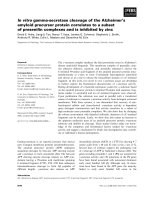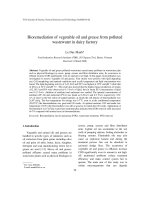Blending of vegetable oils and chemical modification by epoxidation followed by oxirane ring-opening reaction
Bạn đang xem bản rút gọn của tài liệu. Xem và tải ngay bản đầy đủ của tài liệu tại đây (2.05 MB, 5 trang )
<span class='text_page_counter'>(1)</span><div class='page_container' data-page=1>
<i>DOI: 10.22144/ctu.jen.2017.013 </i>
<b>BLENDING OF VEGETABLE OILS AND CHEMICAL MODIFICATION BY </b>
<b>EPOXIDATION FOLLOWED BY OXIRANE RING-OPENING REACTION </b>
<b>Phan Hong Phuong, Nguyen Kim Trung, Dao Thi Kim Thoa, Hoang Chi Phu </b>
<i>Ho Chi Minh City University of Technology, Vietnam </i>
<b>Article info. </b> <b> ABSTRACT </b>
<i>Received date: 26/01/2016 </i>
<i>Accepted date: 30/03/2017</i> <i><b> In this paper, vegetable oils as refined soybean oil, refined sunflower oil </b>and their blends of different proportions were investigated for blending </i>
<i>and epoxidation followed by oxirane ring-opening reaction. The </i>
<i>physicochemical properties such as viscosity, acidity value, iodine value </i>
<i>and saponification value were reported. From the results, the blend of </i>
<i>vegetable oils with mass ratio of 80:20 (sunflower oil: soybean oil) had </i>
<i>higher viscosity index than individual vegetable oil, as well as suitable </i>
<i>acidity and saponification value. However, the relatively high iodification </i>
<i>of this blend indicated that this blend had a low oxidation stability. </i>
<i>Hence, this mixture has been continually exposed to epoxidation reaction </i>
<i>with the purpose of removing the presence of double bond C=C followed </i>
<i>by oxirane ring-opening reaction. The results indicated that temperature, </i>
<i>time of reaction, molar ratio H2O2/C=C influenced significantly on iodine </i>
<i>value of obtained blend. The following conditions in epoxidation step: </i>
<i>CH3COOH/C=C 1:1; time of reaction 7h, temperature of reaction 60oC, </i>
<i>stirring speed 500 rpm and H2O2/C=C 3:1 could reduce effectively iodine </i>
<i>value, from 129.6 to 6.9. In the oxiranering-opening reaction, n-butanol </i>
<i>was used as reagent, and the final product had higher viscosity compared </i>
<i>to epoxidized blend. </i>
<i><b>Keywords </b></i>
<i>Blends, epoxidation, iodine </i>
<i>value, oxirane ring-opening </i>
<i>reaction, vegetable oils </i>
Cited as: Phuong, P. H., Trung, N. K., Thoa, D. T. K., Phu, H. C., 2017. Blending of vegetable oils and
chemical modification by epoxidation followed by oxirane ring-opening reaction. Can Tho
<i>University Journal of Science. Vol 5: 109-113. </i>
<b>1 INTRODUCTION </b>
Lubricants consist of about 70-99% of base oil and
1-30% additives. Over 95% of base oil has origin
<i>from mineral oil (Salimon et al., 2012). Depletion </i>
of crude oil and environmental concerns leads to
increasing interest in renewable and biodegradable
lubricants. In this term, vegetable oil is an
alternative to mineral base oil of lubricant. Most of
vegetable oils are made up of triglycerides with
similar length of fatty acids, between 14 and 22
carbon atoms, having different degree of
<i>unsaturation (Fox et al., 2007). In comparison with </i>
mineral base oil, vegetable oils have higher flash
</div>
<span class='text_page_counter'>(2)</span><div class='page_container' data-page=2>
and need to be reduced. In the review of the
au-thors, the epoxidation of a blend of vegetable oils
was not investigated, although there were
<b>research-es into this reaction of different pure vegetable oils. </b>
In this study, physicochemical properties including
viscosity, viscosity index, acid value,
saponifica-tion and iodine value of different vegetable oils and
their blends were analysed. After that, the
epoxida-tion followed by oxirane ring opening of the
suita-ble suita-blended refined soybean and sunflower were
carried out. Different composition of the blend as
well as condition reaction such as chemical agents
ratio, time and temperature of reaction were
<b>inves-tigated. </b>
<b>2 METHODS </b>
<b>2.1 Determination of viscosity, viscosity index, </b>
<b>acid value, iodine value and saponification value </b>
<b>of pure oils and their blends with different </b>
<b>ratios </b>
Viscosity of pure refined soybean oil, sunflower oil
at 40o<sub>C and 100</sub>o<sub>C were determined using </sub>
Redwood viscometer. The blends were prepared in
10:90 to 90:10 of mass ratio, and their values of
viscosity at 40o<sub>C and 100</sub>o<sub>C were measured again </sub>
using the same viscometer. Viscosity index of the
samples deduced from viscosity at 40o<sub>C and </sub>
100o<sub>C. The acid values, iodine values and </sub>
saponification values of pure oils and the blends
were measured by titrametric methods of Pearson.
<b>2.2 Epoxidation of blend oil </b>
Epoxidized oil of 100 g blend of soybean and
sunflower oils with mass ratio at 20:80 was
prepared by reacting the blend oil with mixture of
CH3COOH/H2O2. The product of the reaction was
rinsed with water until complete removal of excess
acid and then distilled to obtain epoxidized oil. The
molar ratio of CH3COOH/C=C in the reaction was
1:1 with 30 ml of CH3COOH, stirring speed was
500 rpm.
The reation temperature varied between 4060o<sub>C, </sub>
molar ratios H2O2/C=C were 1:1, 2:1, 3:1
alternately, time of reaction was investigated
between 4 and 7h.
<b>2.3 Oxirane ring-opening reaction of </b>
<b>epoxidized blend oil </b>
The reation was investigated on the obtained
epox-idized oil in the conditions described in previous
part using n-butanol reagents. The epoxidized oil
was stirred with n-butanol at 90o<sub>C, then </sub>
concentrated H2SO4 was dropped into the mixture
gradually and temperature was raised to 100o<sub>C. </sub>
The mixture was left for reaction in 3h, after that
washed with distilled water and dried at 80o<sub>C </sub>
un-der vacuum pressureto remove n-butanol and
water. The product obtained was then compared to
specified based oils in lubricating fabrication.
<b>3 RESULTS AND DISCUSSION </b>
<b>3.1 Viscosity and Viscosity Index of pure oils </b>
<b>and their blends in different ratios </b>
Viscosity and Viscosity Index (VI) are ones of the
most important properties of industrial lubricant.
The VI range of mineral oil based lubricant is often
90-100. For very high viscosity index mineral oil
based stocks, VI varies from 110 to 130. The
appearance of Oxygen containing compounds in
synthetic base oil increases VI to 120-160. As seen
in Table 1, these two properties vary with respect
to blended oil composition. The blend of refined
sunflower oil and refined soybean oil with mass
ratio of 80:20 had the highest VI of 235.71 among
tested blends.The suitability of molecular structure
in the two oils might be a reason of this
phenome-non. Viscosity of the blend at 40o<sub>C and 100</sub>o<sub>C </sub>
changed slightly with its composition and were
near viscosity of pure oils. This might be because
there is no significant difference in molecular
structure of pure oils. The vegetable oils have
mainly in their structure oleic and linoleic acid.
Viscosity value of vegetable oils differs slightly
because of their difference in saturated acid content
<i>(Talkit et al., 2012). </i>
<b>Table 1: Viscosity and Viscosity Index of pure </b>
<b>vegetable oils and their blends </b>
<b>Refined sunflower oil: </b>
<b>Refined soybean oil </b>
<b>(mass ratio) </b>
<b>υ at </b>
<b>40o<sub>C, </sub></b>
<b>cSt </b>
<b>υ at </b>
<b>100o<sub>C, </sub></b>
<b>cSt </b>
<b>VI </b>
100:0 30.58 7.25 215.21
80:20 28.65 7.26 235.71
60:40 29.21 7.15 223.32
50:50 30.06 7.19 216.79
40:60 29.01 7.16 226.35
20:80 29.91 7.20 219.16
0:100 29.83 7.16 217.54
<b>3.2 Acid value, iodine value and saponification </b>
<b>value </b>
</div>
<span class='text_page_counter'>(3)</span><div class='page_container' data-page=3>
mixture act as a better lubricating oil blend than
<i>others (Marotrao et al., 2012). </i>
<b>Table 2: Acid value pure of vegetable oils and </b>
<b>their blends </b>
<b>Refined sunflower oil: </b>
<b>Re-fined soybean oil </b>
<b>(mass ratio) </b>
<b>Acid value </b>
100:0 0.048
80:20 0.062
40:60 0.094
0:100 0.126
<b>Table 3: Saponification value of vegetable oils </b>
<b>and their blends </b>
<b>Refined sunflower oil: </b>
<b>Re-fined soybean oil </b>
<b>(mass ratio) </b> <b>Saponification value </b>
100:0 196.49
80:20 194.95
40:60 191.19
0:100 191.92
Determination of saponification value is necessary
to ascertain the fixed oil in lubricants. This
saponification value is significant in animal oil or
vegetable oil based lubricants because the mineral
oil does not undergo saponification. Accordingly,
saponification value of vegetable oil fits to be used
as base oil in lubricants is 186-198 (Gawrilow,
2003). So, from Table 3, saponification value of all
pure oils and blended oils was situated in this
range.
<b>Table 4: Iodine value of vegetable oils and their </b>
<b>blends </b>
<b>Refined sunflower oil: </b>
<b>Re-fined soybean oil </b>
<b>(mass ratio) </b>
<b>Iodine value </b>
100:0 129
80:20 129.6
40:60 130.8
0:100 132
Iodine value of vegetable oil fits to be used as
base oil in lubricants is 94-126 (Gawrilow, 2003).
As seen in Table 4, iodine value of sunflower oil is
129 and that of soybean oil is 132. The mixture of
sunflower oil and soybean oil of 80: 20 (mass
ratio) was 129.6. This value is higher than expected
value applied in vegetable base oil lubricants.
Hence, further studied related to the decrease of
unsaturation degree of this oil mixture is needed.
<b>3.3 Epoxidation reaction </b>
<i>3.3.1 Influene of reaction temperature on </i>
<i>conversion of C=C bond </i>
The reactions were carried out in the following
conditions: reaction time of 4 h, molar ratio of
H2O2/C=C of 1:1, molar ratio of CH3COOH/C=Cof
1:1, stiring speed of 500 rpm. The reaction
temperature was changed in the range 4060o<sub>C and </sub>
iodine value of obtained epoxidized product was
determined. The results were displayed in Table 5.
<b>Table 5: Iodine value of epoxidized produced at </b>
<b>different reaction temperature </b>
<b>Temperature (o<sub>C) </sub></b> <b><sub>Iodine index (g I2/100g) </sub></b>
40 89.8
50 84.1
60 52.6
Regarding Table 5, when the temperature rose
from 40 to 60o<sub>C, the iodine index decreased from </sub>
89.8 to 52.6. This indicated that unsaturation level
of product dropped, and the conversion of C=C
bond into oxirane ring increased. At 60o<sub>C, the </sub>
conversion of C=C bond was 59.41%.
Howerver, when the temperatureincreased
continually to 70o<sub>C, the catalyst (H</sub>
2SO4) became a
strong oxidant which boosted the polymer reaction.
On the other hand, when the temperature exceeded
over 80o<sub>C, oxirane ring could be opened by the </sub>
agent such as water or acid acetic in the reaction
mixture. Therefore, the suitable temperature to
investigate was 60o<sub>C. </sub>
<i>3.3.2 Influence of molar ratio H2O2/C=C on </i>
<i>conversion of C=C bond </i>
Epoxidation was carried out at 60o<sub>C, 500 rpm, </sub>
mo-lar ratio of CH3COOH/C=C 1:1 in 4 h. Molar ratios
of H2O2/ C=C were varied to 1:1, 1:2 and 3:1. The
iodine value of obtained products were measured
and presented in Table 6.
<b>Table 6: Iodine value of epoxidized produced at </b>
<b>different molar ratio of H2O2/C=C </b>
<b>Molar ratio H2O2/ C=C Iodine index (g I2/100g) </b>
1:1 52.6
2:1 43.3
3:1 31.2
As seen in the table, when molar ratio H2O2/C=C
increased from 1:1 to 3:1, iodine value decreased
correspondly from 56.2 to 31.2. This change is
reasonable since more H2O2 will shift equilibrium
of its reaction with CH3COOH to form more
</div>
<span class='text_page_counter'>(4)</span><div class='page_container' data-page=4>
step. At molar ratio H2O2/C=C of 3:1, temperature
of 60o<sub>C, conversion of C=C bond in the original </sub>
blend was 75.93%.
The molar ratio of H2O2/C=C is limited to 3:1 to
ensure that the reaction takes place safely because
of strongly oxidising character of H2O2 and
strongly exothermic reaction.
<i>3.3.3 Influence of reaction time on conversion of </i>
<i>C=C bond </i>
The epoxidation was proceeded at suitable
temper-ature and molar ratio H2O2/C=C in the conditions
described in the previous part and time of reaction
was varied between 4 and 7 h. The results were
recorded in Table 7.
<b>Table 7: Iodine value of epoxidized produced at </b>
<b>different time of reaction </b>
<b>Reaction time (h) </b> <b>Iodine index (g I2/100g) </b>
4 31.2
5 9.9
7 6.9
The conversion of C=C bond went up significantly
from 75.93% to 92.36% if the time extended from
4 to 5 h. Following that, it increased slowly by
2.32% when the reaction carried out more 2 h.
Therefore, the time of reaction plays an important
role in the epoxidation and it may be investigated
to 10 or 20 h until the reaction occurs completely.
<b>3.4 Oxirane ring opening </b>
As investigated, the mixture of refined sunflower
and soybean oil with mass ratio of 80:20 which
suffered epoxidation at 60o<sub>C, molar ratio of </sub>
H2O2/C=Cof 3:1, reaction time of 7 h has improved
viscosity index and especially iodine value.
How-ever, viscosity value of this product is still slow
and needs to be increased in some applications.
Thus, oxirane ring opening of the epoxidized
prod-uct was carried out with expectation to boost
vis-cosity values. In this reaction, n-butanol was
se-lected to be agent because of its suitability
struc-ture. Viscosity values of ring-opened product are
measured and showed in Table 8.
<b>Table 8: Viscosity value of final product after </b>
<b>oxirane ring-opening reaction </b>
<b>Viscosity at 40o<sub>C </sub></b> <b><sub>48.40 </sub></b>
Viscosity at 100o<sub>C </sub> <sub>9.67 </sub>
Viscosity index 190.88
The result showed that the viscosity of final
prod-uct was higher than original blended vegetable oil.
However, the viscosity index went down to 190.88
compared with 235.71 of the blend of vegetable
oils. In addition, the pour point of ring-open
prod-uct was 5o<sub>C being lower than original blend oil </sub>
(7o<sub>C). </sub>
After blending, the obtained oil had equal quality
with the base stock SN150, but there were
limita-tions in its thermo-oxidative stability and its high
pour point. After the modification in the structure,
the viscosity of oil was similar with mineral oil
SN250, the iodine value decreased effectively, the
pour point reduced but still high. Therefore, this
pour point is expected to be improved by adding
pour point depressant additive in manufacturing
lubricants.
<b>4 CONCLUSIONS </b>
Blending oil is a simple method to make vegetable
oil become more applicable as a base oil in
lubri-cant. Compared to pure vegetable oil, the blend of
refined sun flower oil with soybean oil of 80:20
(mass ratio) was the best blended one among
oth-ers. This mixture had the highest VI value of
235.71, suitable acidic and saponification values.
However, there was still the presence of much C=C
bond in the molecular chain. The results indicated
that by changing the reaction condition in
epoxida-tion and oxirane ring-opening reacepoxida-tion, the iodine
value of the blend oil could be improved
effective-ly. At 60o<sub>C, molar ratio H</sub>
2O2/C=C of 3:1, reaction
time of 7 h, molar ratio CH3COOH/C=Cof 1:1 with
30 ml of CH3COOH, stirring speed of 500 rpm, the
epoxidized product had iodine value of 6.9
com-pared to the original blend oil of 129.6. This
indi-cated that the resistance to oxidation of epoxidized
<i>blended vegetable oil is improved significantly. </i>
<i><b>ACKNOWLEDGEMENT </b></i>
This research is funded by Ho Chi Minh City
Uni-versity of Technology under grant number
<i>T-KTHH-2015-72. </i>
<b>REFERENCES </b>
Salimon, J., Salih, N., Yousif, E., 2012. Improvement of
pour point and oxidative stability of synthetic ester
basestocks for biolubricant applications. Arabian
Journal of Chemistry, 153: 193-200.
</div>
<span class='text_page_counter'>(5)</span><div class='page_container' data-page=5>
Campanella, A., Rustoy, E., Baldessari, A., Baltanás,
M.A., 2010. Lubricants from chemically modified
vegetable oils. Bioresource Technology. 101: 245-254.
Lathi, P.S. Mattiasson, B., 2007. Green approach for the
preparation of biodegradable lubricant base stock
from epoxidized vegetable oil. Applied Catalysis B:
Environmental. 69: 207-212.
Marotrao, T.K., 2012. Physicochemical peroperties of oil
blend and their effects on lubrication properties.
In-ternational journal of advanced engineering research
and studies. 1: 35-38.
Gawrilow, I., 2003. Palm Oil Usage in Lubricants. Paper
presented at 3rd Global Oils and Fats Business
Fo-rum USA. Interfacing with the Global Oils and Fats
Business.1–19.
</div>
<!--links-->









